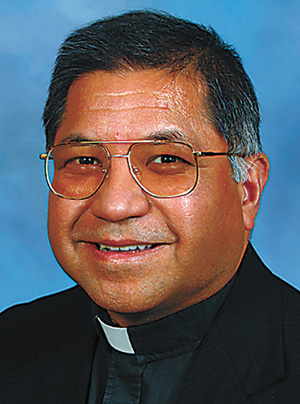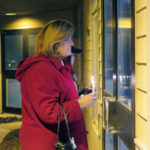(Editor’s note: The following is an English reflection that Father Rudolph Juarez gave May 7 during a diocesan pilgrimage for Spanish-speaking Catholics).
Good morning to all and welcome to the Cathedral of the Sacred Heart of Jesus. I hope that your trip was pleasant. We have persons here from different points in the diocese. It is a joy to be with you on this pilgrimage since we as Hispanics share a long history and tradition of pilgrimage. It’s been a few years now since I entered into the Sanctuary of San Juan Nuevo in Michoacán dancing as is tradition there. Today without my morning coffee I entered the cathedral shaking and crawling.

The truth is the concept of pilgrimage is not exclusively Christian. Buddhists travel to the site of the birth of the Buddha in Kapilavatsu, India; Muslims are famous for their sanctuaries in Medina and Mecca. In fact, the Spanish refrain “from the Mosque to Mecca” to describe someone who goes from here to there or everywhere, is famous. But hopefully no one uses that Mexican refrain for us which goes: “You are everywhere but at Mass.”
In his work “Peregrinatio,” St. Agustine speaks of pilgrimage as “A Christina spiritual journey as self-imposed exile where the pilgrim looks for the truth of God in his wanderings while visiting shrines of the Faith.” Our parishes are shrines of faith for those of us who have had “to learn to love God in foreign territory,” as the saying goes. But the truth is that all of us are sojourners in “Terra Incognita,” unknown land, because our home is not in this world – but rather in heaven as St. Paul reminds us when he says that our citizenship is in heaven.
Well and good. At the beginning of the Christian era, the places where our Lord walked with his Apostles became holy sites of pilgrimage. In the fourth century, Ss. Paul and Eustochia in a letter to a Roman matron spoke of the importance of visiting the Holy Land, using the same words of Scripture to speak of the universality of these sites: “We are Parthians, Medes and Elamites. We live in Mesopotamia, Judea, and Capppadocia, Pontus and the province of Asia…” So it is nice that we have Ottumwans, Columbus Junctionites, Muscatinites, and a few others from West and Iowa City and maybe even some from Tepito (a crime-ridden barrio in Mexico City).
During the Middle Ages, pilgrimages were a common thing for those who had the means and the time to take a break from their daily life. The greatest pilgrimage of course was to the Holy Land. But when the Middle East became a Muslim world, Europe became the pilgrimage of choice – since Europe enjoyed the benefit of being a “Christian civilization.” Unfortunately now, few attend Mass in Europe and few call themselves Christian. And the most popular name of male babies born in Europe now is Muhammed.
The four most popular sites of pilgrimage in Europe were: the churches of SS. Peter and Paul in Rome, the cathedral of St. Thomas Beckett in England, the Cathedral of Cologne – famous for its relics of the three kings and the Cathedral of St. James of Compostela, Spain, where the one who traveled forests and mountains to visit the shrine of the great Evangelist of the Iberian peninsula would return home with a shell as proof that they had traveled to Finisterra – the end of the earth.
Pilgrimage and penance often went hand in hand. It was custom that one would make a pilgrimage as a penance for a grave sin — so surely your pastors have sent you here for that reason! Or, to give thanks for a favor received.
When Christian civilization reached the New World, the custom of pilgrimages and holy sites continued and many sites were established. Take for instance the shrine of Our Lady of Good Success in Quito, Ecuador, where since 1610 Sister Mariana’s incorrupt body can be found and the Virgin is venerated under that title of Our Lady of Good Success. Or take the shrine in Chimayo, New Mexico, Our Lady of Guadalupe and Our Lady of San Juan de los Lagos, or the Holy Infant shrine in Plateros, Zacatecas, or Our Lady of Coromoto in Venezuela, Our Lady of the Rosary in Guatemala and La Aparecida in Brazil – and so many more. But all this is testimony to our incarnate God and God who is truly with us.
It is this fact that God is with us which brings us here to this place of pilgrimage. And we come hopefully, with the motive of “looking for God’s truth” and to implore the forgiveness of our sins. Beware said the great saint that we become one of those “who wander much but are hallowed little.”
In this Year of Mercy promulgated by Pope Francis, the Holy Father has asked that in every diocese in the world there be appointed holy sites of pilgrimage. These sites should have a set of Holy Doors by which the faithful might pass. For those who walk through those doors a plenary indulgence is granted to them and to their loved ones from the temporal punishment of sin in purgatory if within weeks: they confess their sins, pray for the intentions of the Holy Father and receive holy Communion.
What a blessing that you have come today. We will soon be celebrating the sacrament of reconciliation and then the holy Mass. It does not matter from where we come, but it does matter where we hope to go. St. Agustine said something key to understanding this pilgrimage of our lives: “We draw close to the one who is everywhere present and everywhere whole, not by our feet, but by our hearts.”











